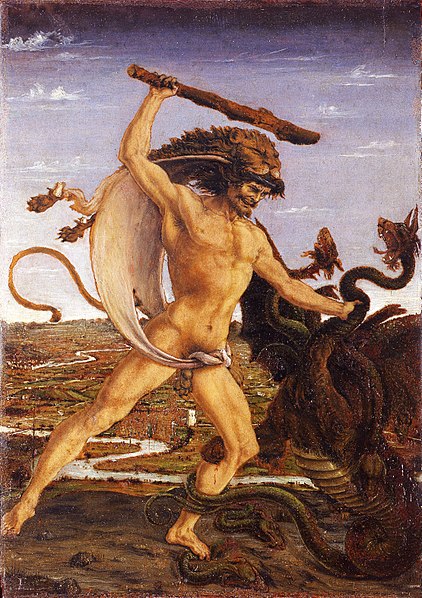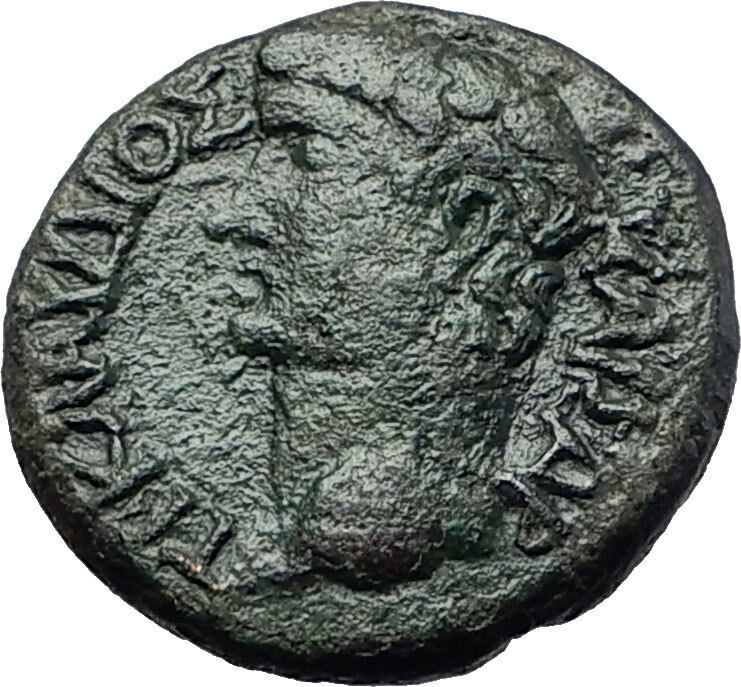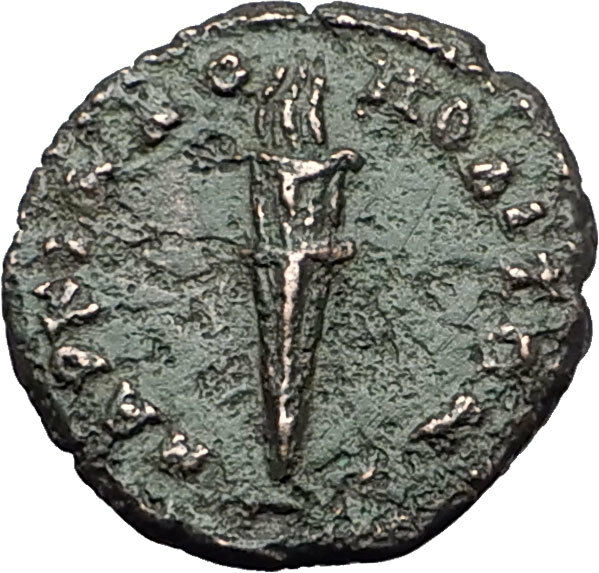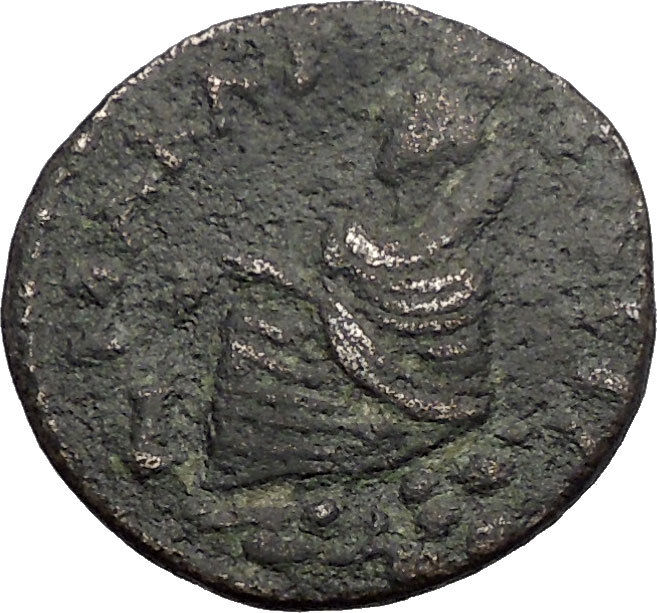Item: i48502

Authentic Ancient Coin of:
Septimius Severus – Roman Emperor : 193-211 A.D. –
Bronze 18mm (2.84 grams) of Nicopolis ad Istrum in Moesia Inferior in Moesia Inferior 193-211 A.D.
Laureate, draped and cuirassed bust right.
Bearded head of Hercules left.
You are bidding on the exact item pictured, provided with a Certificate of Authenticity and Lifetime Guarantee of Authenticity.
Hercules is the Roman name for the Greek divine hero Heracles , who was the son of Zeus (Roman equivalent Jupiter ) and the mortal Alcmene . In classical mythology , Hercules is famous for his strength and for his numerous far-ranging adventures.

The Romans adapted the Greek hero’s iconography and myths for their literature and art under the name Hercules. In later Western art and literature and in popular culture , Hercules is more commonly used than Heracles as the name of the hero. Hercules was a multifaceted figure with contradictory characteristics, which enabled later artists and writers to pick and choose how to represent him. This article provides an introduction to representations of Hercules in the later tradition .
Labours
Hercules is known for his many adventures, which took him to the far reaches of the Greco-Roman world . One cycle of these adventures became canonical as the “Twelve Labours,” but the list has variations. One traditional order of the labours is found in the Bibliotheca as follows:
- Slay the Nemean Lion .
- Slay the nine-headed Lernaean Hydra .
- Capture the Golden Hind of Artemis .
- Capture the Erymanthian Boar .
- Clean the Augean stables in a single day.
- Slay the Stymphalian Birds .
- Capture the Cretan Bull .
- Steal the Mares of Diomedes .
- Obtain the girdle of Hippolyta , Queen of the Amazons .
- Obtain the cattle of the monster Geryon .
- Steal the apples of the Hesperides .
- Capture and bring back Cerberus .
The Latin name Hercules was borrowed through Etruscan , where it is represented variously as Heracle , Hercle, and other forms. Hercules was a favorite subject for Etruscan art , and appears often on bronze mirrors . The Etruscan form Herceler derives from the Greek Heracles via syncope . A mild oath invoking Hercules (Hercule! or Mehercle!) was a common interjection in Classical Latin .

Baby Hercules strangling a snake sent to
kill him in his cradle (Roman marble, 2nd century CE)
Hercules had a number of myths that were distinctly Roman. One of these is Hercules’ defeat of Cacus , who was terrorizing the countryside of Rome. The hero was associated with the Aventine Hill through his son Aventinus . Mark Antony considered him a personal patron god, as did the emperor Commodus . Hercules received various forms of religious veneration , including as a deity concerned with children and childbirth , in part because of myths about his precocious infancy, and in part because he fathered countless children. Roman brides wore a special belt tied with the “knot of Hercules”, which was supposed to be hard to untie.[4] The comic playwright Plautus presents the myth of Hercules’ conception as a sex comedy in his play Amphitryon ; Seneca wrote the tragedy Hercules Furens about his bout with madness. During the Roman Imperial era , Hercules was worshipped locally from Hispania through Gaul.
Medieval mythography
After the Roman Empire became Christianized , mythological narratives were often reinterpreted as allegory , influenced by the philosophy of late antiquity . In the 4th century, Servius had described Hercules’ return from the underworld as representing his ability to overcome earthly desires and vices, or the earth itself as a consumer of bodies. In medieval mythography, Hercules was one of the heroes seen as a strong role model who demonstrated both valor and wisdom, with the monsters he battles as moral obstacles. One glossator noted that when Hercules became a constellation , he showed that strength was necessary to gain entrance to Heaven.
Medieval mythography was written almost entirely in Latin, and original Greek texts were little used as sources for Hercules’ myths.
Renaissance mythography
The Renaissance and the invention of the printing press brought a renewed interest in and publication of Greek literature. Renaissance mythography drew more extensively on the Greek tradition of Heracles, typically under the Romanized name Hercules, or the alternate name Alcides . In a chapter of his book Mythologiae (1567), the influential mythographer Natale Conti collected and summarized an extensive range of myths concerning the birth, adventures, and death of the hero under his Roman name Hercules. Conti begins his lengthy chapter on Hercules with an overview description that continues the moralizing impulse of the Middle Ages:
Hercules, who subdued and destroyed monsters, bandits, and criminals, was justly famous and renowned for his great courage. His great and glorious reputation was worldwide, and so firmly entrenched that he’ll always be remembered. In fact the ancients honored him with his own temples, altars, ceremonies, and priests. But it was his wisdom and great soul that earned those honors; noble blood, physical strength, and political power just aren’t good enough.
Nicopolis ad Istrum was a Roman and Early Byzantine town founded by Emperor Trajan around 101-106, at the junction of the Iatrus (Yantra) and the Rositsa rivers, in memory of his victory over the Dacians . Its ruins are located at the village of Nikyup , 20 km north of Veliko Tarnovo in northern Bulgaria . The town reached its apogee during the reigns of Trajan, Hadrian , the Antonines and the Severan dynasty .

The classical town was planned according to the orthogonal system. The network of streets, the forum surrounded by an Ionic colonnade and many buildings, a two-nave room later turned into a basilica and other public buildings have been uncovered. The rich architectures and sculptures show a similarity with those of the ancient towns in Asia Minor. Nicopolis ad Istrum had issued coins, bearing images of its own public buildings.
In 447 AD , the town was destroyed by Attila’s Huns . Perhaps it was already abandoned before the early 400s. In the 6th century, it was rebuilt as a powerful fortress enclosing little more than military buildings and churches, following a very common trend for the cities of that century in the Danube area.The largest area of the extensive ruins (21.55 hectares) of the classical Nicopolis was not reoccupied since the fort covered only one fourth of it (5.75 hectares), in the southeastern corner. The town became an episcopal centre during the early Byzantine period. It was finally destroyed by the Avar invasions at the end of the 6th century. A Bulgarian medieval settlement arose upon its ruins later (10th-14th century).
Nicopolis ad Istrum can be said to have been the birthplace of Germanic literary tradition. In the 4th century, the Gothic bishop, missionary and translator Ulfilas (Wulfila) obtained permission from Emperor Constantius II to immigrate with his flock of converts to Moesia and settle near Nicopolis ad Istrum in 347-8. There, he invented the Gothic alphabet and translated the Bible from Greek to Gothic .
L ucius Septimius Severus (or rarely Severus I) (April 11, 145/146-February 4, 211) was a Roman general, and Roman Emperor from April 14, 193 to 211. He was born in what is now the Berber part of Rome’s historic Africa Province .
ucius Septimius Severus (or rarely Severus I) (April 11, 145/146-February 4, 211) was a Roman general, and Roman Emperor from April 14, 193 to 211. He was born in what is now the Berber part of Rome’s historic Africa Province .
Septimius Severus was born and raised at Leptis Magna (modern Berber , southeast of Carthage , modern Tunisia ). Severus came from a wealthy, distinguished family of equestrian rank. Severus was of Italian Roman ancestry on his mother’s side and of Punic or Libyan -Punic[1] ancestry on his father’s. Little is known of his father, Publius Septimius Geta , who held no major political status but had two cousins who served as consuls under emperor Antoninus Pius . His mother, Fulvia Pia’s family moved from Italy to North Africa and was of the Fulvius gens, an ancient and politically influential clan, which was originally of plebeian status. His siblings were a younger Publius Septimius Geta and Septimia Octavilla. Severus’s maternal cousin was Praetorian Guard and consul Gaius Fulvius Plautianus .[2]
In 172, Severus was made a Senator by the then emperor Marcus Aurelius . In 187 he married secondly Julia Domna . In 190 Severus became consul , and in the following year received from the emperor Commodus (successor to Marcus Aurelius) the command of the legions in Pannonia .
On the murder of Pertinax by the troops in 193, they proclaimed Severus Emperor at Carnuntum , whereupon he hurried to Italy. The former emperor, Didius Julianus , was condemned to death by the Senate and killed, and Severus took possession of Rome without opposition.
The legions of Syria , however, had proclaimed Pescennius Niger emperor. At the same time, Severus felt it was reasonable to offer Clodius Albinus , the powerful governor of Britannia who had probably supported Didius against him, the rank of Caesar, which implied some claim to succession. With his rearguard safe, he moved to the East and crushed Niger’s forces at the Battle of Issus . The following year was devoted to suppressing Mesopotamia and other Parthian vassals who had backed Niger. When afterwards Severus declared openly his son Caracalla as successor, Albinus was hailed emperor by his troops and moved to Gallia. Severus, after a short stay in Rome, moved northwards to meet him. On February 19 , 197 , in the Battle of Lugdunum , with an army of 100,000 men, mostly composed of Illyrian , Moesian and Dacian legions, Severus defeated and killed Clodius Albinus, securing his full control over the Empire.
Emperor
Severus was at heart a soldier , and sought glory through military exploits. In 197 he waged a brief and successful war against the Parthian Empire in retaliation for the support given to Pescennius Niger. The Parthian capital Ctesiphon was sacked by the legions, and the northern half of Mesopotamia was restored to Rome.
His relations with the Roman Senate were never good. He was unpopular with them from the outset, having seized power with the help of the military, and he returned the sentiment. Severus ordered the execution of dozens of Senators on charges of corruption and conspiracy against him, replacing them with his own favorites.
He also disbanded the Praetorian Guard and replaced it with one of his own, made up of 50,000 loyal soldiers mainly camped at Albanum , near Rome (also probably to grant the emperor a kind of centralized reserve). During his reign the number of legions was also increased from 25/30 to 33. He also increased the number of auxiliary corps (numerii), many of these troops coming from the Eastern borders. Additionally the annual wage for a soldier was raised from 300 to 500 denarii .
Although his actions turned Rome into a military dictatorship , he was popular with the citizens of Rome, having stamped out the rampant corruption of Commodus’s reign. When he returned from his victory over the Parthians, he erected the Arch of Septimius Severus in Rome.
According to Cassius Dio,[3] however, after 197 Severus fell heavily under the influence of his Praetorian Prefect, Gaius Fulvius Plautianus , who came to have almost total control of most branches of the imperial administration. Plautianus’s daughter, Fulvia Plautilla , was married to Severus’s son, Caracalla. Plautianus’s excessive power came to an end in 205, when he was denounced by the Emperor’s dying brother and killed.[4] The two following praefecti, including the jurist Aemilius Papinianus , received however even larger powers.
Campaigns in Caledonia (Scotland)
Starting from 208 Severus undertook a number of military actions in Roman Britain , reconstructing Hadrian’s Wall and campaigning in Scotland .
He reached the area of the Moray Firth in his last campaign in Caledonia, as was called Scotland by the Romans.[5]. In 210 obtained a peace with the Picts that lasted practically until the final withdrawal of the Roman legions from Britain [6] , before falling severely ill in Eboracum (York).
Death
He is famously said to have given the advice to his sons: “Be harmonious, enrich the soldiers, and scorn all other men” before he died at Eboracum on February 4 , 211[7].
Upon his death in 211, Severus was deified by the Senate and succeeded by his sons, Caracalla and Geta , who were advised by his wife Julia Domna .[8]
The stability Severus provided the Empire was soon gone under their reign.
Accomplishments and Record
Though his military expenditure was costly to the empire, Severus was the strong, able ruler that Rome needed at the time. He began a tradition of effective emperors elevated solely by the military. His policy of an expanded and better-rewarded army was criticized by his contemporary Dio Cassius and Herodianus : in particular, they pointed out the increasing burden (in the form of taxes and services) the civilian population had to bear to maintain the new army.
Severus was also distinguished for his buildings. Apart from the triumphal arch in the Roman Forum carrying his full name, he also built the Septizodium in Rome and enriched greatly his native city of Leptis Magna (including another triumphal arch on the occasion of his visit of 203).
Severus and Christianity
Christians were persecuted during the reign of Septimus Severus. Severus allowed the enforcement of policies already long-established, which meant that Roman authorities did not intentionally seek out Christians, but when people were accused of being Christians they could either curse Jesus and make an offering to Roman gods , or be executed. Furthermore, wishing to strengthen the peace by encouraging religious harmony through syncretism , Severus tried to limit the spread of the two quarrelsome groups who refused to yield to syncretism by outlawing conversion to Christianity or Judaism . Individual officials availed themselves of the laws to proceed with rigor against the Christians. Naturally the emperor, with his strict conception of law, did not hinder such partial persecution, which took place in Egypt and the Thebaid , as well as in Africa proconsularis and the East. Christian martyrs were numerous in Alexandria (cf. Clement of Alexandria , Stromata, ii. 20; Eusebius , Church History, V., xxvi., VI., i.). No less severe were the persecutions in Africa, which seem to have begun in 197 or 198 (cf. Tertullian’s Ad martyres), and included the Christians known in the Roman martyrology as the martyrs of Madaura . Probably in 202 or 203 Felicitas and Perpetua suffered for their faith. Persecution again raged for a short time under the proconsul Scapula in 211, especially in Numidia and Mauritania . Later accounts of a Gallic persecution, especially at Lyon, are legendary. In general it may thus be said that the position of the Christians under Septimius Severus was the same as under the Antonines ; but the law of this Emperor at least shows clearly that the rescript of Trajan [ neededclarification] had failed to execute its purpose..
Frequently Asked Questions
How long until my order is shipped?:
Depending on the volume of sales, it may take up to 5 business days for shipment of your order after the receipt of payment.
How will I know when the order was shipped?:
After your order has shipped, you will be left positive feedback, and that date should be used as a basis of estimating an arrival date.
After you shipped the order, how long will the mail take?
USPS First Class mail takes about 3-5 business days to arrive in the U.S., international shipping times cannot be estimated as they vary from country to country. I am not responsible for any USPS delivery delays, especially for an international package.
What is a certificate of authenticity and what guarantees do you give that the item is authentic?
Each of the items sold here, is provided with a Certificate of Authenticity, and a Lifetime Guarantee of Authenticity, issued by a world-renowned numismatic and antique expert that has identified over 10000 ancient coins and has provided them with the same guarantee. You will be quite happy with what you get with the COA; a professional presentation of the coin, with all of the relevant information and a picture of the coin you saw in the listing.
Compared to other certification companies, the certificate of authenticity is a $25-50 value. So buy a coin today and own a piece of history, guaranteed.
Is there a money back guarantee?
I offer a 30 day unconditional money back guarantee. I stand behind my coins and would be willing to exchange your order for either store credit towards other coins, or refund, minus shipping expenses, within 30 days from the receipt of your order. My goal is to have the returning customers for a lifetime, and I am so sure in my coins, their authenticity, numismatic value and beauty, I can offer such a guarantee.
Is there a number I can call you with questions about my order?
You can contact me directly via ask seller a question and request my telephone number, or go to my About Me Page to get my contact information only in regards to items purchased on eBay.
When should I leave feedback?
Once you receive your order, please leave a positive. Please don’t leave any negative feedbacks, as it happens many times that people rush to leave feedback before letting sufficient time for the order to arrive. Also, if you sent an email, make sure to check for my reply in your messages before claiming that you didn’t receive a response. The matter of fact is that any issues can be resolved, as reputation is most important to me. My goal is to provide superior products and quality of service.






